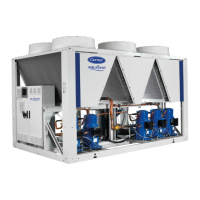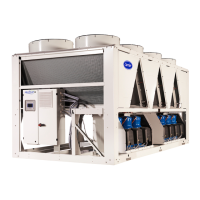Frost protection
The protection provided to the evaporator against low pressure
and frost depends on the amount of antifreeze in the water loop.
The evaporator pinch (LWT – SST) and the antifreeze protection
depend on this level.
It is therefore crucial to check the amount of antifreeze in the
loop carefully during the initial system start-up (allow it to circulate
for 30 minutes to check that the mixture is homogeneous before
sampling).
Refer to the manufacturer's data to dene the frost protection,
based on the measured concentration amount.
The minimum temperature for frost protection must be entered in
the parameters on the unit's controller.
This value will enable the following limits to be dened:
1. Evaporator antifreeze protection.
2. Low pressure protection.
For information, based on the antifreeze solutions used in our
laboratories, the protection values provided by our supplier are
as follows (these values may change depending on the supplier):
It is therefore recommended that a low temperature installation
be commissioned by the manufacturer.
Required glycol concentration
Freezing curve for Ethylene and Propylene glycol
Glycol concentration (%)
0
5
10
15
20
25
30
35
40
45
50
-26 -24 -22 -20 -18 -16 -14 -12 -10 -8 -6 -4 -2 0
Ethylène glycol (%)
Propylène glycol (%)
Minimum frost protection temperature (°C)
Ethylene glycol (%)
Propylene glycol (%)
Minimum frost protection temperature to be observed
based on the leaving water temperature.
Minimum frost protection temperature based on the
water outlet temperature (example)
-25
-20
-15
-10
-5
0
-16 -14 -12 -10 -8 -6 -4 -2 0 2 4 6
Minimum frost protection temperature (°C)
Water outlet temperature (°C)
For example, based on the above curves, if the ethylene glycol
mass concentration measured in the loop is 30%, the frost
protection temperature value of -14.8 °C must be entered in the
software. This corresponds to a minimum leaving water
temperature of -6.7 °C. The control point must be added as a
result.
IMPORTANT:
• It is vital to check the glycol content at least once a year
and adjust the software's frost protection based on the
measured level.
• This procedure must be performed systematically if
water or antifreeze solution is added.
• Observe the minimum frost protection temperature
based on the water outlet temperature.
NOTE:
• In the case of frost protection of the unit by low air
temperature, the percentage brine must be evaluated
accordingly.
• The maximum glycol content for units equipped with a
hydraulic module is 45 %.
• The maximum recommended temperature dierential
is 5 K.
• To facilitate maintenance operations, it is recommended
that isolation valves are installed upstream and
downstream of the machine
12 - OPTIONS
70

